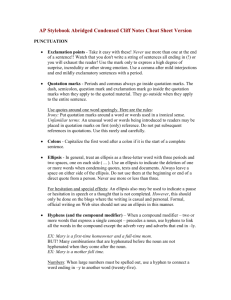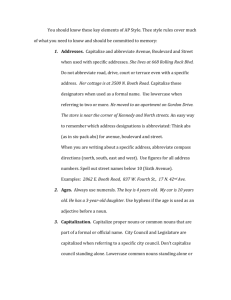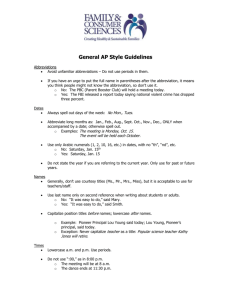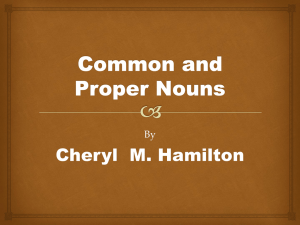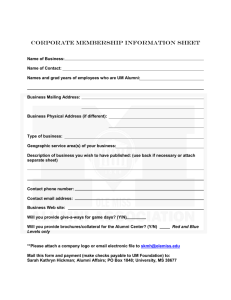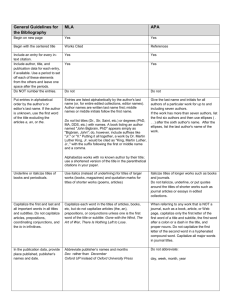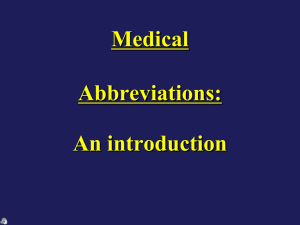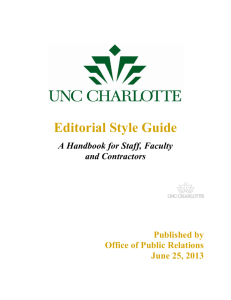UW INFORMATION SCHOOL WEB STYLE GUIDE
advertisement
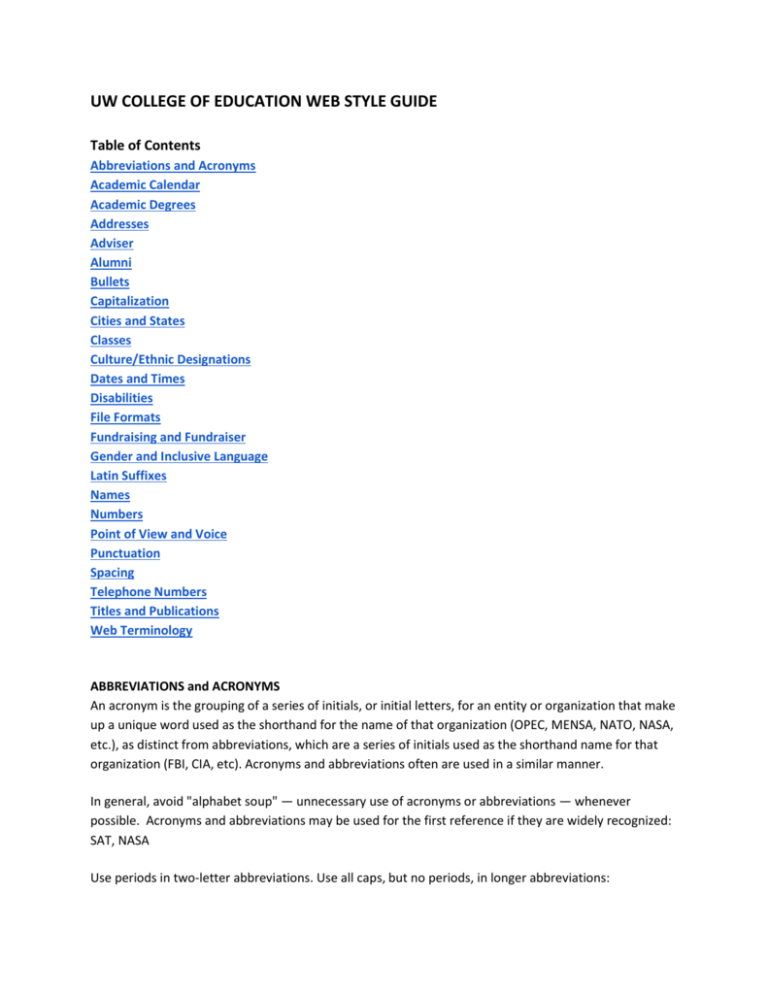
UW COLLEGE OF EDUCATION WEB STYLE GUIDE Table of Contents Abbreviations and Acronyms Academic Calendar Academic Degrees Addresses Adviser Alumni Bullets Capitalization Cities and States Classes Culture/Ethnic Designations Dates and Times Disabilities File Formats Fundraising and Fundraiser Gender and Inclusive Language Latin Suffixes Names Numbers Point of View and Voice Punctuation Spacing Telephone Numbers Titles and Publications Web Terminology ABBREVIATIONS and ACRONYMS An acronym is the grouping of a series of initials, or initial letters, for an entity or organization that make up a unique word used as the shorthand for the name of that organization (OPEC, MENSA, NATO, NASA, etc.), as distinct from abbreviations, which are a series of initials used as the shorthand name for that organization (FBI, CIA, etc). Acronyms and abbreviations often are used in a similar manner. In general, avoid "alphabet soup" — unnecessary use of acronyms or abbreviations — whenever possible. Acronyms and abbreviations may be used for the first reference if they are widely recognized: SAT, NASA Use periods in two-letter abbreviations. Use all caps, but no periods, in longer abbreviations: U.S., U.N., Ph.D. (even though it has the small "h"), BSE, YMCA, CIA ACADEMIC CALENDAR The academic year begins autumn quarter, followed by winter, spring and summer quarters. The name of the quarter is lowercase, unless used at the beginning of a sentence or headline. ACADEMIC DEGREES Capitalize full degree names such as Bachelor of Education, Master of Education, Doctor of Education and always use them on first reference. Use acronyms where applicable only on subsequent reference. Use an apostrophe and lower case for bachelor’s degree and master’s degree. ● ● ● ● ● ● Minor in Education Bachelor of Arts Master of Education Master of Teaching Doctor of Education Doctor of Philosophy minor bachelor’s degree master’s degree master’s degree doctorate doctorate ELS B.A. M.Ed. MIT Ed.D. Ph.D. The word "degree" should not follow an abbreviation: ● She has a B.A. in Education. ● She has a bachelor's degree in Education. ADDRESSES Use abbreviations for Ave., St., Blvd., Ct., La., Pl., Rd., Dr. and Pkwy. Spell out street designations such as the less common Terrace and Circle or anytime when not accompanied by an address number: ● He lives on State Street. ● Her office address is 2 S. Status St. ADVISER not advisor. ALUMNI Avoid using only class years behind the names of students and alumni (e.g., Jane Jones '12) unless content is for an internal audience and/or there is a long list. ● senior Jane Jones ● Jane Jones, a senior ● Jane Jones, a member of the Class of 2012 ● Several undergraduates were selected to serve on the committee: senior Jane Jones, sophomore David Smith, freshman John Doe and junior Betty Anderson. ● Several undergraduates and alumni were selected to serve on the committee: Betty Anderson '84, John Doe '15, Jane Jones '12 and David Smith '67. Preferred for alumni in external publications: ● ● Wendy Kapp, a 1989 University of Washington alumna, is the founder of Teachers for America. Wendy Kapp, a 1989 iSchool graduate, is the founder … Suggested style for alumni in internal publications: ● David Peters MPA '85, Ph.D. '87. Preferred style for alumni who did not graduate: ● Jane Jones, who attended Princeton from 2004 to 2006 … BULLETS Use a colon to introduce a list only when the text following the colon does not flow naturally from it. Here are examples of punctuation: The students in the Tuesday afternoon seminar were asked to read a chapter in a novel from the 18th century; write an essay comparing it with a chapter in a novel from the 20th century; and complete both assignments by 5 p.m. The students in the Tuesday afternoon seminar have three assignments: ● Read a chapter in a novel from the 18th century. ● Write an essay comparing it with a chapter in a novel from the 20th century. ● Complete both projects by 5 p.m. Bulleted items may be capped or lowercase, depending on preference. Be consistent throughout the document. Generally, items that are complete sentences should be capped, and those that are fragments should be lowercase. CAPITALIZATION People’s Titles Capitalize a job title when it immediately precedes a person's name. The title is not capitalized when it is an incomplete designation, follows a name or is on second reference: ● University President Michael Young ● Michael Young, president of University of Washington ● the president ● Professor of Educational Psychology Jane Doe ● Jane Doe, professor of educational psychology ● professor Jane Doe ● the professor Departments, Offices, the Board of Trustees Capitalize the formal names of departments and offices, as well as the Board of Trustees; do not capitalize informal names and incomplete designations: ● ● ● ● ● ● ● ● College of Education Department of Educational Psychology the educational psychology department the department the Office of Admission the admission office the office Student Services Buildings, Places, Centers Capitalize the word "University" whenever referring to University of Washington. Capitalize the formal names of buildings, places and centers. Use the formal name on first reference and, in most cases, use lowercase on second reference: ● Suzzallo Library ● the library ● University of Washington Henry Art Gallery ● the art gallery ● Miller Hall ● The hall has four rooms. ● The University allows ... (capitalize the "U" when referring to University of Washington) ● At any university, students will ... Forms Capitalize the full names of forms: ● Application for Undergraduate Admission and Scholarships ● Request for Graduate Application Fee Waiver Lowercase shortened or general forms: ● admission application ● fee waiver form Events The formal names of special events are capitalized: ● Alumni Day ● Baccalaureate ● Class Day ● Commencement ● Opening Exercises ● Reunions Headers and Menu Links ● Title case for all headings, subheaders and headlines/event titles ● Sentence case for all navigational menu links Languages Do not capitalize major areas of study, unless referring to a language: ● She is studying economics and French. CITIES and STATES Spell out the names of the 50 U.S. states when they stand alone, but use the state abbreviations listed in this section when a state is listed with a city, town, village, etc. However, keep in mind the audience for which you are writing. Many international readers do not understand U.S. state abbreviations. It may be best to write them out in materials designated primarily for global audiences. Use of United States: ● She studied U.S. culture of the 1950s. ● She studied the culture of the United States from the 1950s. States Use lowercase for state, as in Washington state The first name listed should be used with a city, town, village, etc.; the second is the zip code abbreviation to use when referencing a full postal address in text. Ala. (AL) Maine (ME) Okla. (OK) Alaska (AK) Md. (MD) Ore. (OR) Ariz. (AZ) Mass. (MA) Pa. (PA) Ark. (AR) Mich. (MI) R.I. (RI) Calif. (CA) Minn. (MN) S.C. (SC) Colo. (CO) Miss. (MS) S.D. (SD) Conn. (CT) Mo. (MO) Tenn. (TN) Del. (DE) Mont. (MT) Texas (TX) Fla. (FL) Neb. (NE) Utah (UT) Ga. (GA) Nev. (NV) Vt. (VT) Hawaii (HI) N.H. (NH) Va. (VA) Ill. (IL) N.J. (NJ) Wash. (WA) Ind. (IN) N.M. (NM) W.Va. (WV) Iowa (IA) N.Y. (NY) Wis. (WI) Kan. (KS) N.C. (NC) Wyo. (WY) Ky. (KY) N.D. (ND) La. (LA) Ohio (OH) Do not use states with these U.S. cities: Atlanta Houston Philadelphia Baltimore Indianapolis Phoenix Boston Las Vegas Pittsburgh Chicago Los Angeles St. Louis Cincinnati Miami Salt Lake City Cleveland Milwaukee San Antonio Dallas Minneapolis San Diego Denver New Orleans San Francisco Detroit New York City Seattle Honolulu Oklahoma City Washington Do not use country names with these foreign cities: Amsterdam Bangkok Beijing Baghdad Beirut Berlin Brussels London Rio de Janeiro Cairo Luxembourg Rome Djibouti Macau San Marino Dublin Madrid Sao Paulo Geneva Mexico City Shanghai Gibraltar Milan Singapore Guatemala City Monaco Stockholm Havana Montreal Sydney Helsinki Moscow Tokyo Hong Kong Munich Toronto Islamabad New Delhi Vatican City Istanbul Panama City Vienna Johannesburg Paris Zurich Jerusalem Prague Kuwait City Quebec City CLASSES Capitalize the word "Class" in the Class of 1976 CULTURE/ETHNIC DESIGNATIONS Use "people of color" or "underrepresented" in stories where it is appropriate to identify people by race; include the specific group(s) being identified in these stories. Avoid using the term "minority," if possible. Do not use a hyphen when African American is used as a noun or an adjective. This applies to all such ethnic classifications. In general, native is lowercase unless used with American: She is Native American. It is his native land. DATES and TIMES Use figures for days of the month. Omit the ordinal designations of nd, rd, st, th. Place a comma between the month and the year when the day is mentioned: ● On April 27, 2009, Major Event brought together hundreds of people. Do not place a comma between the month and the year when the day is not mentioned: ● In April 2009, Major Event brought together hundreds of people. When a month is used with a specific date, abbreviate the month according to AP style: Jan., Feb., Aug. Sept., Oct., Nov. and Dec. (all others spelled out). Spell out when using alone or with a year alone: ● Aug. 27, 2011 ● August ● August 2011 Use the year, a hyphen and the last two digits to refer to a period of time within the same century as an adjective, but full years joined by a hyphen when the range crosses into another century: ● the 2011-12 academic year ● the 1999-2000 academic year Use "to" instead of a hyphen when the year or time is a noun: ● from 1989 to 2005 ● The meetings will take place from 8 to 11 a.m. Monday through Friday. When abbreviating years to two digits, put an apostrophe in front of the years: ● the Class of '76 ● the summer of '66 Dates following a day of the week should be set apart by commas: ● He decided that Friday, Oct. 12, would be a convenient date. Times generally come before days and dates: ● The performance will take place at 3 p.m. Friday, Oct. 12. When emphasizing the exact time, or when using a.m. or p.m., use figures (omitting 00 for on the hour): ● 7 p.m.; 7:30 p.m. ● 12 a.m. should be referred to as midnight; 12 p.m. should be referred to as noon. Hyphens may be used with dates, and should always be used with dates when both days of the week and dates are included. ● The workshop is set for Monday through Thursday, July 18-21. Centuries and decades: ● Noun: the 20th century ● Adjective: 20th-century literature ● the 1960s ● '60s fashion DISABILITIES In general, do not describe an individual as disabled or handicapped. If it is relevant to the material and you must use a description, try to be specific: ● Muhammad Ali, boxing hero and a former Olympic champion, defied the symptoms of Parkinson's to light the torch in a rare public appearance. Use "accessible parking," rather than disabled or handicapped parking. FILE FORMATS If a file format acronym is being used in a sentence, it should be set in all caps. ● I used three GIF images in my design. If a file format acronym is being used to indicate the type of downloadable file in a link, it should be set in lowercase with a "." preceding it. ● The image (.gif) is available for download. ● Commencement 2011 press release (.pdf) FUNDRAISING and FUNDRAISER Always one word GENDER and INCLUSIVE LANGUAGE Use nonsexist language and follow these recommendations: Don't say "he" when referring to an unspecified person. Instead, recast the sentence into the plural, or avoid the use of pronouns altogether. ● (Incorrect) Each student is expected to turn in his paper by the deadline. ● (Correct) Students are expected to turn in their papers by the deadline. If it's impossible to solve the problem using these approaches, remember that "he or she" is preferable to "he/she." Avoid gender-specific titles or terms, such as: Instead of Use chairman chair businessman business executive, manager cameraman camera operator coed female student congressman representative, senator fireman firefighter foreman supervisor founding fathers founders mailman mail carrier to man to staff, to run, to operate mankind people, humanity manpower workforce, employees policeman police officer LATIN SUFFIXES ● alumnus/alumni (male graduate/plural; also plural for a group consisting of male and female graduates) ● alumna/alumnae (female graduate/plural) ● emerita/emeritae (retired faculty woman who keeps her rank or title/plural) ● emeritus/emeriti (retired faculty man who keeps his rank or title/plural; also plural for a group consisting of male and female retirees) For official publications, use alumnus for a male and alumni when even just one male in a group; use alumna or alumnae when referring to females exclusively. NAMES As a general rule, use only first name and last name unless the person is widely known and identified in professional or industry circles with an initial or middle name. Always use the president of the University's first name, middle initial and last name on first reference. Formal names (not nicknames) are preferred, unless the tone of the material is very informal. ● President Michael Young ● Tom Stritikus, dean of the College of Education Use an individual’s first and last names on first reference. On subsequent references, use last name only. In cases where two people have the same last name, continue to use first and last names. NUMBERS Spell out numbers one through nine and general numbers in narrative text: ● There were seven people at the meeting. ● There were 36 students in the class. ● There are approximately 5,000 undergraduates. ● There are a thousand reasons. When a number is the first word of a sentence, spell it out. In a series, apply the appropriate guideline: There are 25 graduate students in the philosophy department, nine in the music department and eight in the comparative literature department, making a total of 42 students in the three departments. Express all percentages as figures. Do not use the % sign except in charts or graphs: ● 3 percent; 130 percent For very large sums of money use figures with a dollar sign; spell out million or billion: ● $1.8 million ● between $1 and $2 billion Place a comma after digits signifying thousands, except when reference is made to temperature: ● 1,160 students ● 2200 degrees Fahrenheit Use the words "more than" and "less than" instead of "over" and "under" in conjunction with numbers: ● More than 200 students signed the petition. POINT OF VIEW and VOICE When writing content for the website or print materials, use second-person narrative, unless writing a course description. Course descriptions are written in third person. Do not use first person references such as ‘we’ except when referring to the College of Education mission/vision statements. ● At the College of Ecuation, you study the history of education. Faculty and staff support your career goals. ‘You’ is the most important word when writing anything except course descriptions. Use active not passive verbs and make them punchy: Hellacious winds whipped the building rather than the building was whipped by hellacious winds. PUNCTUATION Commas Use commas to separate elements in a series and do not put a comma before the conjunction in a simple series: The flag is red, white and blue Dashes Use an em dash to relay a break in thought. Place a single space on either side of the em dash. This is the longer dash ("—") as compared to the shorter en dash ("–") or two hyphens ("--"). Em dashes are created by holding down the SHIFT+OPTION+MINUS SIGN keys on a Mac or the ALT+CTRL+MINUS SIGN keys on a PC. Chartered in 1746 as the College of New Jersey — the name by which it was known for 150 years — Princeton University was British North America's fourth college. An em dash can be used to set off elements within a sentence. The materials used by the artist — wood, steel and plastic — created a powerful contrast. Hyphens Hyphen: - ("-" on keyboard) Do not hyphenate words beginning with non, except if there is a proper noun: ● non-American; nonscholarship Do not place a hyphen between the prefixes pre, semi, anti, sub, etc., and nouns or adjectives, except before proper nouns, but avoid duplicated vowels or consonants: ● reapply ● semidetached ● antiwar ● ongoing ● prerequisite ● pre-enroll Use hyphens to connect compound modifiers, being careful about meaning: ● white-hot metal or white hot metal (depending on which is meant) ● calculator-wielding graduate student Do not use a hyphen on adverbs ending in -ly: ● an easily hit ball ● a badly cooked egg ● a loudly ringing phone Hyphenate part-time and full-time only when used as adjectives: ● She has a full-time job at the College of Education. ● She works at the College of Education full time. Use a hyphen between numbers: ● 231-29-0002 ● 2002-03 (not 2002-2003) Use a hyphen, not a comma, to separate institutions from their city locations: ● the University of California-Berkeley ● the University of Texas-Austin No hyphens: campuswide, Universitywide Quotation Marks The period and comma always go inside the quotation marks: ● "He will stop by tomorrow," she said. The question mark goes inside when part of the direct quote, outside when applying to quoted material within an entire sentence. ● "Will you explain distribution requirements to me?" asked the student. ● What is meant by "distribution requirements"? The semicolon goes outside quoted material within a sentence: ● Refer to them as "conference participants"; all others should be known as "guests." Semicolons Use the semicolon to set off a series that includes commas: ● The main offices are in Mercer County, N.J.; Marion County, Ind.; and Broward County, Fla. SPACING Use a single space between words and sentences. TELEPHONE NUMBERS Use area codes with hyphens for all telephone numbers, or at least once with a listing. This practice has become necessary because of the increasing use of cell phones: ● 206-258-3000 ● For international numbers (country code, city code, telephone number): 011-44-20-7535-1515 ● For 800 numbers: 800-222-7474 TITLES Courtesy Titles Do not use courtesy titles (Mr., Miss, Ms., Mrs.). Names followed by Jr., Sr. or a Roman numeral do not have a comma after the last name: ● Martin Luther King Jr. ● James Hart III Publications, Course Listings, Films, Music, Works of Art As a general rule, put titles of books and articles in initial caps and quotation marks: ● "The Grapes of Wrath" Put titles of newspapers, magazines and journals in initial caps with NO quotation marks: ● Science ● Nature ● The Daily Capitalize "the" in a publication's name, if that is how it appears in the masthead: ● The New York Times In text, put the course name in quotation marks: ● He selected "Introduction to Economic Dynamics" after meeting with his adviser. Capitalize the titles of lectures, theses and dissertations: ● He gave the lecture "In Pursuit of Flight" to the class of auditors. Titles of songs are usually set in quotation marks: ● "Old Nassau" Use quotation marks around a musical composition's nickname but not a composition identified by its sequence. ● Dvorak's "New World Symphony," Dvorak's Symphony No. 9 Titles of paintings, drawings, statues and other works of art are put in quotation marks. ● Leonardo da Vinci's "Mona Lisa" WEB TERMINOLOGY ● email (or Email at the beginning of a sentence) ● enews ● Facebook page ● homepage ● Internet ● log in, log out (verb) ● login (noun) ● netID ● ● ● ● ● ● online the Web webpage Twitter feed website World Wide Web URLs Use the shortest URL possible. For root-level sites, do not use "http://" or the "trailing slash": ● ischool.uw.edu, not http://www.ischool.uw.edu/main/ Email Addresses Should appear as we have it here: ● For more information, contact John Doe at 206-258-3000 or jdoe@uw.edu. Style on Social Media Sometimes when text appears on Facebook and other social media, editorial style is more relaxed to save space on short posts. More specific guidelines are provided in the University's social media strategies, policies and best practices. RESOURCES UW Style Guide www.washington.edu/externalaffairs/uwmarketing/toolkits/editorial-style-and-standards/ Princeton Style Guides http://www.princeton.edu/communications/services/editorial/resources/style-guide/

